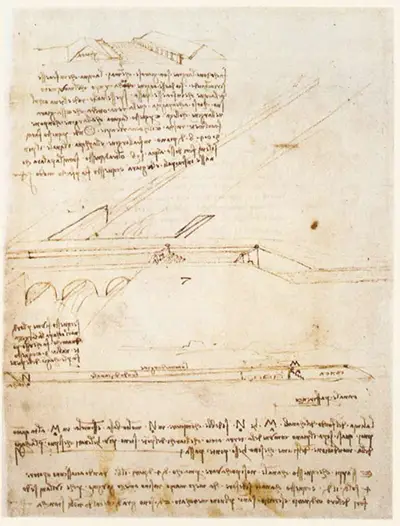The pen and ink on paper drawing is taken from the Codex Atlanticus, 1478-1518.
Leonardo is most famous for his skills as an artist, however his insatiable curiosity led to a fascination in an immense number of subjects, including science, architecture, invention and engineering. His ventures into the design of bridges is evidence of this.
Leonardo da Vinci made an extensive study of the motion of water. He felt encouraged to utilise this force and generated many ideas for machinery that would do this.
A lot of Leonardo da Vinci's work regarding hydraulics was for Ludovico il Moro, the Duke of Milan from 1494 up to 1499. Ludovico is most known for being the man who commissioned Leonardo's famous painting, The Last Supper.
Leonardo revealed to Ludovico a written insight into his ideas, claiming that he could build, 'very light and strong bridges that can easily be carried, with which to pursue, and sometimes flee from, the enemy; and others safe and indestructible by fire or assault, easy and convenient to transport and place into position'.
Leonardo da Vinci investigated the potential he saw by devising a plan to create a movable dyke that would protect the city of Venice against invaders.
When in Florence, he also conceived and developed the idea of flooding the Tuscany city of Pisa, by diverting the course of the river Arno. However, this proved to be too expensive to be realised.
Leonardo da Vinci also created many sketches for bridges, such as the canal bridge shown here. The construction of canals involved cutting though land, including roads and footpaths, resulting in the need for new bridges.
These were often hump-backed brick or stone bridges, with an arch accommodating the canal and towpath beneath. Leonardo's design is an elaborate version of this, and features several arches below a flat bridge.
Another of Leonardo da Vinci's designs was a single span 240 meter bridge that featured as part of a civil engineering project for Ottoman Sultan Beyazid II of Istanbul. In his plans for the bridge, the construction would span an inlet at the mouth of the Bosphorus, located in Turkish Straits, known as the Golden Horn.
Leonardo da Vinci's vision was dismissed as impossible and was never realised in his lifetime. However, in 2001, in Norway, as smaller bridge based on this design was successfully constructed.
Bridges were not Leonardo's only invention regarding canals, however, and one of his most enduring achievements was his creation of the miter lock. The miter lock is a canal lock that continues to be used extensively in canals to this day.


